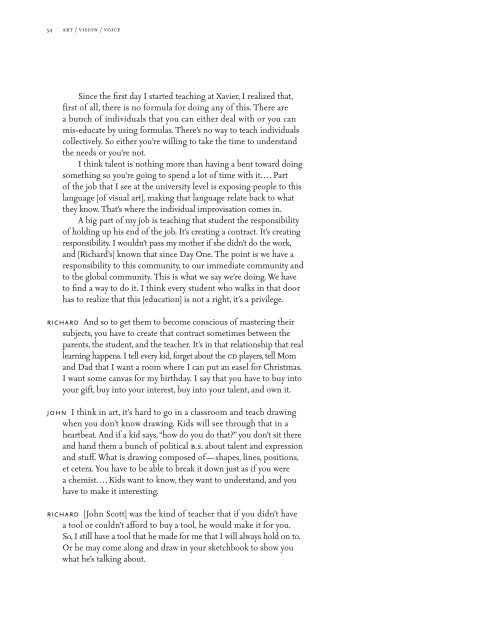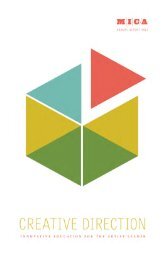art/vision/voice - Maryland Institute College of Art
art/vision/voice - Maryland Institute College of Art
art/vision/voice - Maryland Institute College of Art
Create successful ePaper yourself
Turn your PDF publications into a flip-book with our unique Google optimized e-Paper software.
54 <strong>art</strong> / <strong>vision</strong> / <strong>voice</strong><br />
Since the first day I st<strong>art</strong>ed teaching at Xavier, I realized that,<br />
first <strong>of</strong> all, there is no formula for doing any <strong>of</strong> this. There are<br />
a bunch <strong>of</strong> individuals that you can either deal with or you can<br />
mis-educate by using formulas. There’s no way to teach individuals<br />
collectively. So either you’re willing to take the time to understand<br />
the needs or you’re not.<br />
I think talent is nothing more than having a bent toward doing<br />
something so you’re going to spend a lot <strong>of</strong> time with it. . . . P<strong>art</strong><br />
<strong>of</strong> the job that I see at the university level is exposing people to this<br />
language [<strong>of</strong> visual <strong>art</strong>], making that language relate back to what<br />
they know. That’s where the individual improvisation comes in.<br />
A big p<strong>art</strong> <strong>of</strong> my job is teaching that student the responsibility<br />
<strong>of</strong> holding up his end <strong>of</strong> the job. It’s creating a contract. It’s creating<br />
responsibility. I wouldn’t pass my mother if she didn’t do the work,<br />
and [Richard’s] known that since Day One. The point is we have a<br />
responsibility to this community, to our immediate community and<br />
to the global community. This is what we say we’re doing. We have<br />
to find a way to do it. I think every student who walks in that door<br />
has to realize that this [education] is not a right, it’s a privilege.<br />
richard And so to get them to become conscious <strong>of</strong> mastering their<br />
subjects, you have to create that contract sometimes between the<br />
parents, the student, and the teacher. It’s in that relationship that real<br />
learning happens. I tell every kid, forget about the cd players, tell Mom<br />
and Dad that I want a room where I can put an easel for Christmas.<br />
I want some canvas for my birthday. I say that you have to buy into<br />
your gift, buy into your interest, buy into your talent, and own it.<br />
john I think in <strong>art</strong>, it’s hard to go in a classroom and teach drawing<br />
when you don’t know drawing. Kids will see through that in a<br />
he<strong>art</strong>beat. And if a kid says, “how do you do that?” you don’t sit there<br />
and hand them a bunch <strong>of</strong> political b.s. about talent and expression<br />
and stuff. What is drawing composed <strong>of</strong>—shapes, lines, positions,<br />
et cetera. You have to be able to break it down just as if you were<br />
a chemist. . . . Kids want to know, they want to understand, and you<br />
have to make it interesting.<br />
richard [John Scott] was the kind <strong>of</strong> teacher that if you didn’t have<br />
a tool or couldn’t afford to buy a tool, he would make it for you.<br />
So, I still have a tool that he made for me that I will always hold on to.<br />
Or he may come along and draw in your sketchbook to show you<br />
what he’s talking about.
















